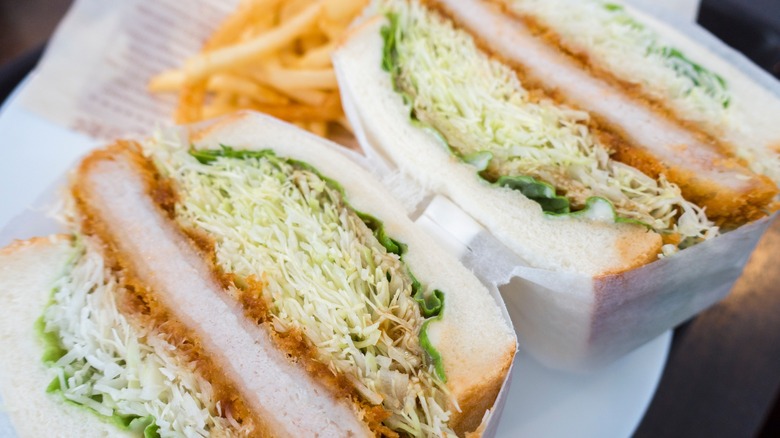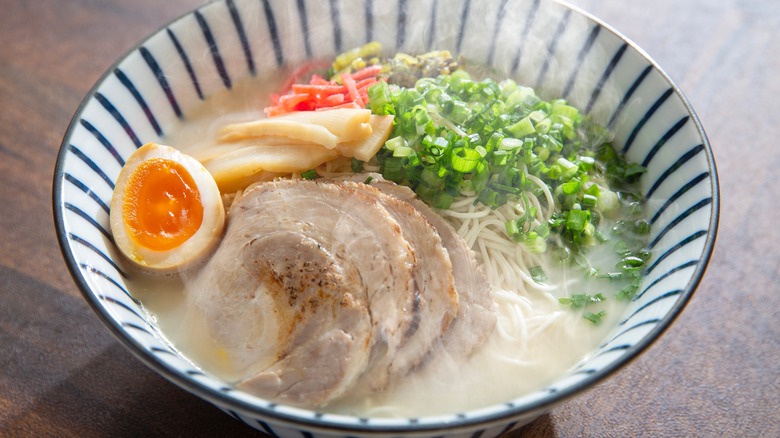Tonkatsu Vs Torikatsu Vs Tonkotsu: The Differences To Memorize
We may receive a commission on purchases made from links.
By exploring the world of food, you're not only discovering new flavors, you're also learning new terminology and even new languages. If you've ever perused a Japanese restaurant menu, you might have noticed three very similar words that can trip up even the most seasoned diner: tonkatsu, torikatsu, and tonkotsu. But once you know the difference, you'll be able to place your next order with confidence.
Tonkatsu and torikatsu are the most similar, both being schnitzel-style meat dishes made with pork or chicken, respectively. Tonkotsu is the odd one out here — despite the name being just one letter away from tonkatsu, tonkotsu is a type of ramen with a rich, creamy broth. Some menus will list it as tonkotsu ramen, which can avoid confusion, but you can also associate the O in the name with the O in broth if that helps you to remember.
All three menu items are considered to be traditional Japanese dishes, though they have been influenced by other cuisines. Tonkatsu and torikatsu are based on the French veal de côtelette de veau, while ramen (including tonkotsu) evolved from the noodle dishes served up by Chinese settlers in Yokohama.
What is tonkatsu?
Tonkatsu is a thick piece of pork that has been breaded in panko and deep fried until golden and crispy. The name can be broken into two parts: ton, meaning pork, and katsu, meaning cutlet. You might also come across hirekatsu and rosukatsu, which are types of tonkatsu. Hirekatsu is made from leaner filet or tenderloin, while rosukatsu is made from the fattier loin.
The classically right way to serve Tonkatsu is with shredded cabbage and katsu sauce, a sweet and tangy condiment made with fruit, vinegar, and spices; something akin to barbecue sauce. It's readily available in the U.S. (with one of the most popular brands being Bull-Dog Tonkatsu Sauce), but you can make a homemade tonkatsu sauce with just a few ingredients.
With these simple accompaniments, tonkatsu is considered a dish in itself, but it's also the base for other dishes. When served with egg over rice, it's known as katsudon, and when covered in thick Japanese curry sauce (kare) it's labelled katsu kare.
What is torikatsu?
Torikatsu is just like tonkatsu but is made with chicken instead of pork. The word tori simply means bird but commonly refers to chicken meat specifically. It's the second most popular meat to use for making katsu after pork, but you might not always see it listed as torikatsu. On English menus, it can often be written as chicken katsu or even panko chicken. Interestingly, the name is sometimes anglicized in Japan and called chikinkatsu.
Torikatsu is usually made with chicken thighs or chicken breast. If you're making it at home, the breasts will first need to be butterflied, and both cuts will need to be pounded to a half inch thick. This ensures your chicken cooks evenly in the center as it crisps up on the outside.
Just like its pork counterpart, torikatsu is often served with simple accompaniments, as part of a meal set, or as the meat component in other dishes like curry. Japan's take on a fried chicken sandwich is the katsu sando: crisp chicken cutlets between slices of impossibly soft milk bread with shredded cabbage, katsu sauce, and kewpie mayo.
What is tonkotsu?
Tonkotsu is a type of ramen that's served with a pork bone broth. The "ton" in this case still refers to pork, and "kotsu" means bones; it's just a coincidence that when written in English, katsu and kotsu are so similar. Different types of ramen are typically categorized by the flavor or broth used, namely tonkotsu (pork bone), shoyu (soy sauce), shio (salt), and miso. Tonkotsu is recognizable for its opaque appearance and creamy mouthfeel, which comes from the collagen in the pork bones that breaks down as they cook.
This style of ramen comes from the Fukuoka region of Japan. It was supposedly invented by accident in 1947 but gained popularity across Japan for being rich and filling, particularly among laborers, who wanted a more sustaining lunch. Tonkotsu ramen is served with thin noodles and typically topped with chashu (braised pork belly), wood ear mushrooms, pickled ginger, green onions, and a soft boiled egg. However, because the name refers to the base, you could serve it as simply broth and noodles or with any kind of topping you like — even sliced tonkatsu.



